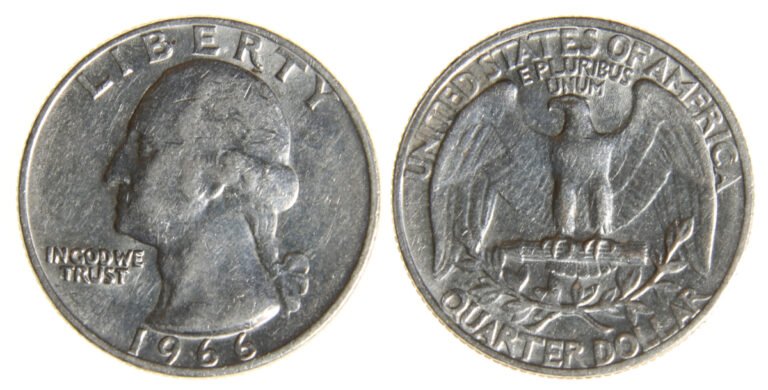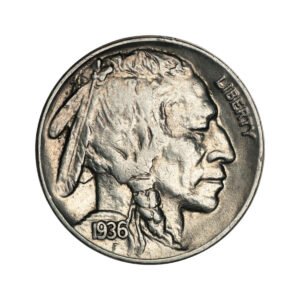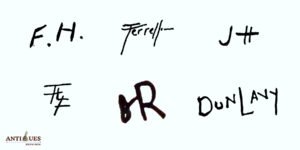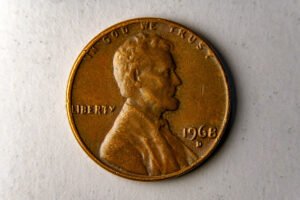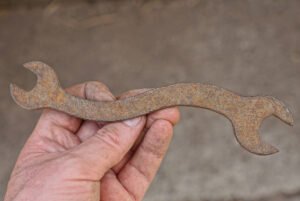Does your old vintage coin collection have a shiny, good-quality 1966 quarter coin? If yes, then you may earn a big fortune with it! That’s right! The 1966 Washington Quarter Dollar represents a transitional period in U.S. coinage that deviated from the silver composition to the more cost-effective copper-nickel clad, making it a historical coin.
However, only the rare 1966 quarters are worth big bucks; most just sell for a few cents to a few dollars. This guide will offer you expert tips to find out if you own a rare quarter dollar. From valuable coin grades to errors, you will learn all the crucial details to assess your 1966 quarter’s worth!
Brief History of the 1966 Washington Quarter
The US Mint began the circulation of Washington Quarters in 1932, commemorating George Washington’s 200th birthday. These quarters were made of 90% silver and 10% copper composition.
However, due to the rising prices of silver, President Lyndon Johnson decided in 1965 to replace traditional silver quarters with a clad composition of cupro-nickel and copper. The 1966 Washington quarter is one of the most popular post-1934 clad quarters.
This new clad composition lasted for 33 long years with the same obverse and reverse designs until the traditional Washington quarter was changed to 50 State quarters, known for its unique designs for 50 US states on the reverse, in 1999.
| 1966 Washington Quarter | Key Facts |
| Coin Composition | copper-nickel-clad |
| Minting Location | Philadelphia, Denver, San Francisco |
| Year of Minting | 1966 |
| Weight | 5.67 g |
| Diameter | 24.26 mm |
| Thickness | 1.75 mm |
| Designer | John Flanagan |
| Face Value | $0.25 (25 cents) |
| Mint Marks | No Mintmarks |
| Total Mintage | 821,101,500 |
Identifying a Real 1966 Quarter (Design & Composition)
Designed by John Flanagan, the 1966 Washington Quarter has the following design and composition features to help you spot it among various old coins.
1966 Quarter Obverse (Heads):

- The left profile of George Washington
- The word “LIBERTY” written above Washington’s head along the upper rim
- The mint year “1966” relief carved below the truncation line of the cameo
- The words “IN GOD WE TRUST” written on the lower-left
1966 Quarter Reverse (Tails):

- The country’s name, “UNITED STATES OF AMERICA,” written along the upper half rim
- A left-facing eagle with spread-out wings and a bundle of arrows in its claws
- The US motto, “E. PLURIBUS UNUM,” written in small fonts above the eagle’s head
- Two olive branches tied together below the eagle
- The denomination words “QUARTER DOLLAR” on the bottom
Coin Composition:
The 1966 Washington Quarter is composed of a copper-nickel-clad, a deviation from the previous 90% silver composition used until 1964. It weighs 5.67 grams and measures 24.3 mm in diameter and 1.75 mm in thickness with a well-reeded edge.
4 Factors to Assess the Value of the 1966 Washington Quarter
Generally, the 1966 Washington quarters are worth around a few cents to a few dollars in commonly found grades. However, extremely high-grade and error coins can have a high value of up to a few thousand dollars.
To find the right price for your old 1966 quarter, you must assess the following four factors:
1. Coin Grade & Condition
The condition of a coin is the most crucial factor to assess its worth. Low-grade 1966 quarters in poor condition are generally not worth much. Even high-mint-state quarters typically have a value of up to $200. But exceptionally high mint grades, such as MS68 or above, can significantly increase the worth of this 25-cent coin.
For instance, the highest PCGS graded 1966 Washington quarter, graded as MS68+, sold for a record price of $21,000 at a Heritage Auctions sale.
| 1966 Quarter’s Grading | Estimated Value |
| Poor (0) to Extremely Fine (XF45) | $0 – $5 (Usually, not worth anything) |
| Almost Uncirculated (AU50) to Mint State (MS60) | $0 – $5 |
| Mint State (MS60 – MS66+) | $5 – $50 |
| Mint State (MS67+ onwards) | $200+ |
2. Rare Mint Errors on the 1966 Washington Quarter
Resulting from mechanical malfunctions during the process of coin striking, mint errors can highly impact the value of your 1966 quarters. Currently, only two valuable 1966 quarter errors have been discovered:
Double Die on Reverse (DDR)
This 1966 quarter coin error features the doubling of letters in the words “UNITED STATES OF AMERICA” and “E. PLURIBUS UNUM” on the coin’s reverse side. One of the very few 1966 25-c DDR coins sold for around $820 via an eBay auction.

Struck on 5C Blank
This is another rare mint error found in the 1966 quarters. As the name suggests, this error coin is struck on a 5-cent planchet. A rare example of the 1966 25C Washington Quarter Dollar Struck on 5C Blank sold for $288 on Heritage Auctions.
3. 1966 Washington Quarter SMS Coins
While there were no proof sets released for the 1966 quarters, the Philadelphia Mint struck over 2,200,000 Special Mint Sets (SMS), according to PCGS. These 1966 25C SMS coins feature a satin-like finish rather than the typical proof-like surfaces.
However, due to high mintage, these SMS quarters are quite common and worth less. The highest price that a 1966 quarter SMS coin in the highest grade, SP68, sold for is $450. Generally, such high-grade SMS coins can be worth thousands of dollars.
4. Mintage & Rarity
The 1966 Washington Quarter Dollars were only struck at the Philadelphia Mint with a total mintage of 821,101,500, which makes this coin easily available and, hence, less valuable in commonly found grades.
Nonetheless, exceptionally high-grade 1966 clad quarter dollars can still be worth as much as a thousand dollar or more, like this rare MS68 example that sold for almost $900 on eBay.

5 Expert Tips to Spot a Fake 1966 Quarter Dollar
Even after learning about these special features, there is a chance that you might overlook a fake 1966 quarter coin. So, follow the 5 simple steps to make sure your 1966 Washington quarter isn’t fake:
- Check the Weight and Dimensions: Authentic 1966 quarters should weigh 5.67 grams and measure 24.3 mm in diameter.
- Check the Edge Reeding: The edge of the 1966 quarter should be reeded, and the reeded edge should be crisp and evenly spaced.
- Look for Mint Mark: Remember, the 1966 quarters do not bear any mint mark. If your quarter coin has a d or s mint mark, it’s a counterfeit coin,
- Check the Magnetic Properties: Put your coin near a magnet; if it’s attracted to the magnet, it’s fake, unlike the real copper-nickel coin, which is non-magnetic.
- Compare to Known Genuine Examples: Familiarize yourself with the appearance of authentic 1966 quarters.
While the 1966 quarters are common, rare examples are highly prized among coin collectors. So, before you buy or sell your old 1966 quarter dollar coins, use this detailed price guide to spot and value them.
Similarly, other quarter coins from this series, such as the 1964 quarter, 1965 quarter, and the 1970 quarter, can also be worth a big fortune! Hop on to my other detailed guides to get expert identification and valuation tips for these coins!

